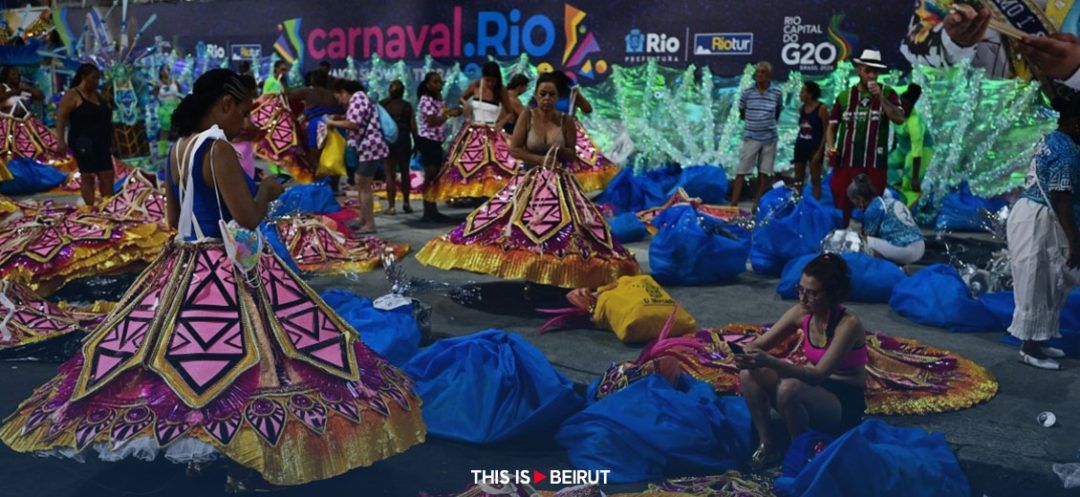
©Photo by Pablo Porciuncula/AFP
The Rio Carnival, a vibrant spectacle of music, dance and culture, crescendos this Sunday with its main event, captivating audiences with dazzling parades and infectious energy. As Rio de Janeiro becomes engulfed in Carnival fever, here are five key aspects illuminating the essence of this iconic celebration.
The Sambodrome
Throughout February, Rio de Janeiro pulsates with Carnival fever, with the Sambodrome serving as the epicenter of festivities. Over two nights, samba schools vie for supremacy in grand parades, featuring elaborate floats, intricate choreography, and dazzling costumes. Each parade can host up to 3,000 participants, captivating crowds of up to 70,000 spectators. This year, 12 schools compete for the prestigious title of Carnival champion, showcasing themes ranging from social and political issues to historical events. Tickets range from $14 to $400, offering spectators a glimpse into Brazil’s rich cultural tapestry.
Street Carnival
While the Sambodrome takes center stage, the heart of the Carnival beats in the lively street blocos. These neighborhood block parties attract thousands of revelers, who dance to live music while adorned in colorful costumes. With themes catering to diverse tastes, blocos like Loucura Suburbana and Zona Mental provide inclusive spaces for all. This year, Rio will host approximately 600 blocos, showcasing the city’s vibrant street culture and infectious energy.
Serious Business
Beneath the surface of revelry lies a substantial economic engine. With the Rio Carnival receiving record funding from the state government and the municipal administration, samba schools received a significant cash injection. The Carnival is projected to inject $1 billion into Rio’s economy, representing an 18% increase from the previous year. Beyond Rio, Carnival festivities contribute to Brazil’s economy, with an estimated $1.8 billion boost nationwide.
[gallery size="large" ids="226007,226008"]
Water Guns and Urine
Amidst the festivities, concerns about safety and sanitation loom large. Recent incidents prompted authorities in Bahia to ban water pistols at parties, highlighting the need for vigilance amidst crowded events. Additionally, the aftermath of Carnival brings challenges, with Rio’s streets marred by the scent of urine. To combat this, the city plans to deploy 2,000 liters of concentrated eucalyptus essence to cleanse the streets post-celebration.
Other Cities Join the Celebration
While Rio may be the crown jewel of the Carnival, cities across Brazil partake in the festivities on a grand scale. Sao Paulo anticipates 15 million revelers, with 500 blocos adding to the city’s vibrant atmosphere. In Belo Horizonte and Recife, millions more join in the revelry, showcasing Brazil’s diverse cultural landscape. Recife holds the Guinness Record for the largest bloco, underscoring the nationwide appeal of Carnival celebrations.
The Rio Carnival transcends mere revelry, embodying Brazil’s rich cultural heritage, economic vitality and communal spirit. As the nation converges to celebrate, the Carnival becomes a symbol of unity, diversity and resilience, showcasing the best of Brazilian culture to the world.
With AFP
The Sambodrome
Throughout February, Rio de Janeiro pulsates with Carnival fever, with the Sambodrome serving as the epicenter of festivities. Over two nights, samba schools vie for supremacy in grand parades, featuring elaborate floats, intricate choreography, and dazzling costumes. Each parade can host up to 3,000 participants, captivating crowds of up to 70,000 spectators. This year, 12 schools compete for the prestigious title of Carnival champion, showcasing themes ranging from social and political issues to historical events. Tickets range from $14 to $400, offering spectators a glimpse into Brazil’s rich cultural tapestry.
Street Carnival
While the Sambodrome takes center stage, the heart of the Carnival beats in the lively street blocos. These neighborhood block parties attract thousands of revelers, who dance to live music while adorned in colorful costumes. With themes catering to diverse tastes, blocos like Loucura Suburbana and Zona Mental provide inclusive spaces for all. This year, Rio will host approximately 600 blocos, showcasing the city’s vibrant street culture and infectious energy.
Serious Business
Beneath the surface of revelry lies a substantial economic engine. With the Rio Carnival receiving record funding from the state government and the municipal administration, samba schools received a significant cash injection. The Carnival is projected to inject $1 billion into Rio’s economy, representing an 18% increase from the previous year. Beyond Rio, Carnival festivities contribute to Brazil’s economy, with an estimated $1.8 billion boost nationwide.
[gallery size="large" ids="226007,226008"]
Water Guns and Urine
Amidst the festivities, concerns about safety and sanitation loom large. Recent incidents prompted authorities in Bahia to ban water pistols at parties, highlighting the need for vigilance amidst crowded events. Additionally, the aftermath of Carnival brings challenges, with Rio’s streets marred by the scent of urine. To combat this, the city plans to deploy 2,000 liters of concentrated eucalyptus essence to cleanse the streets post-celebration.
Other Cities Join the Celebration
While Rio may be the crown jewel of the Carnival, cities across Brazil partake in the festivities on a grand scale. Sao Paulo anticipates 15 million revelers, with 500 blocos adding to the city’s vibrant atmosphere. In Belo Horizonte and Recife, millions more join in the revelry, showcasing Brazil’s diverse cultural landscape. Recife holds the Guinness Record for the largest bloco, underscoring the nationwide appeal of Carnival celebrations.
The Rio Carnival transcends mere revelry, embodying Brazil’s rich cultural heritage, economic vitality and communal spirit. As the nation converges to celebrate, the Carnival becomes a symbol of unity, diversity and resilience, showcasing the best of Brazilian culture to the world.
With AFP
Read more



Comments